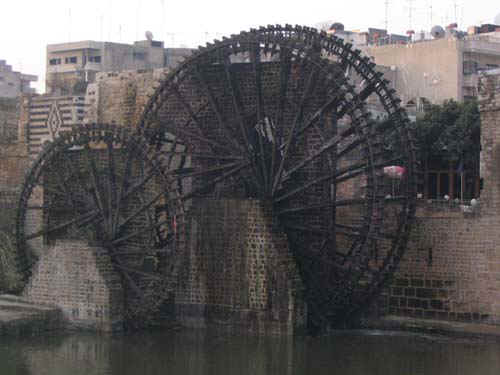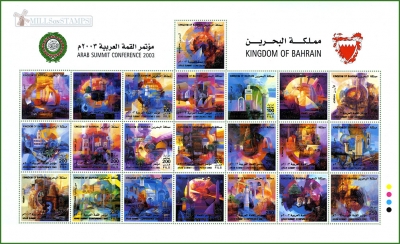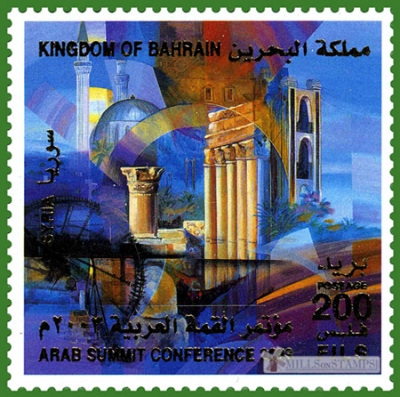-
Arab Summit Conference
Bahrain 2003.03.01
In issue: Stamp(s): 22 Sheet(s): 1
Printing: lithography with foil application
Issued in: sheets of 22 as one set
-
Number by catalogue: Michel: 761 Yvert: 728 Scott: 586o
Perforation type: 13x13
Subject:
200 fils. A collage from symbols of Syria. In a left angle of stamp it is represented noria** from Hama*
Additional:
*Hama (ancient Hamath; Arabic: حماة, meaning fortress) is a city on the banks of the Orontes river in central Syria north of Damascus. It is the provincial capital of the Hama Governorate. It is the location of the historical city Hamath.
Its population numbers 410,000 inhabitants, making it the fifth-largest city in Syria, after Damascus, Aleppo, Homs and Latakia.
Hama is an important agricultural and industrial center in Syria, with 3,680 square kilometres (1,420 sq mi) (over a third of the governorate's area) under cultivation. The governorate produces over half of the national crop of potatoes and pistachio nuts, as well as growing a variety of other vegetables and supporting a healthy livestock ranching industry besides.
The city proper is renowned for its 17 norias used for watering the gardens, which — it is claimed — date back to 1100 BC. Though historically used for purpose of irrigation, nowadays the norias** constitutes an almost entirely esthetic traditional show.
**A noria (Arabic: ناعورة, nā‘ūra, from Syriac: ܢܥܘܪܐ, nā‘urā) is a machine for lifting water into a small aqueduct, either for the purpose of irrigation or, in at least one known instance, to feed seawater into a saltern.
There are three types of noria. The most common examples consist of a vertical wheel which is slung with a chain of buckets. The buckets hang down into a well which may be up to 8m (26ft) deep. The most primitive norias of this type are driven by donkeys, mules, or oxen. The animal turns another wheel, which is engaged with the noria and so causes it to turn. This causes the buckets to circulate.
A second type of noria uses the same system, of a necklace of clay or wooden buckets, but it is driven by the wind. The wind driven norias in the vicinity of Cartagena, Spain, are virtually identical in appearance with the local grinding mills.
The third type of noria uses the energy derived from the flow of a river. It consists of a large, very narrow undershot waterwheel whose rim is made up of a series of containers which lift water from the river to a very small aqueduct at the top of the wheel. Unlike the water wheels found in mills, a noria does not provide mechanical power to any other process. Its concept is similar to the modern hydraulic ram, which also uses the power of flowing water to pump some of the water out of the river.
A few norias were hybrids, consisting of an animal-driven waterwheel.
A noria can raise water to somewhat less than its full height. The largest noria in the world, with a diameter of about 20 meters, is located in the Syrian city of Hama.
It performs a similar function to chain pumps (including the saqiya), and other pumps, that of moving water from a lower elevation to that of a higher elevation, but these are generally powered by other means, not by a waterwheel).It has been suggested that the cakkavattaka mentioned in an Indian text of c.350 BC was a noria, but others dispute this (see watermill). It is certainly referred to by Lucretius (d. 55 BC), who alluded to 'rivers that turn wheels and buckets. This device may have been used in the ancient Near East since circa 200 BC.
Norias later became more widespread during the Muslim Agricultural Revolution and were in large-scale use in the medieval Islamic world,[3] where Muslim inventors and engineers made a number of improvements to the noria. For example, the flywheel mechanism used to smooth out the delivery of power from a driving device to a driven machine, was invented by Ibn Bassal (fl. 1038-1075) of al-Andalus, who pioneered the use of the flywheel in the noria and chain pump (Sakia or saqiya). In 1206, Al-Jazari introduced the use of the crankshaft in a noria and saqiya, and the concept of minimizing intermittent working was implied for the purpose of maximising their efficiency.
Muslim engineers used norias to discharge water into aqueducts which carried the water to towns and fields. Some of the norias used in the medieval Islamic world were as large as 20 meters in diameter, the one in Hama being a surviving example still used in modern times. It has 120 water collection compartments and could raise as much as 95 litres of water per minute.
During the period of agricultural expansion in Song China the technology of norias was improved. For some centuries they had been used for moving water for drainage or irrigation purposes. The simplest design, such as the counterbalanced bucket or 'well-sweep' was found almost universally. A more complicated design, the 'square-pallet chain pump' was introduced several centuries before the growth in Song technology, but had not been used until then for farming. They became more common around the end of the first millennium AD.
The contribution of norias to agricultural growth during the Song was extolled by poets such as Li Ch'u-ch'uan(李处权) of the 12th Century. The Song government actively spread the technology, introducing pumping equipment and norias to those areas as yet unfamiliar with the techniques.Size (of sheet, booklet) mm: 310x121
Topics: Irrigation and water wheels



